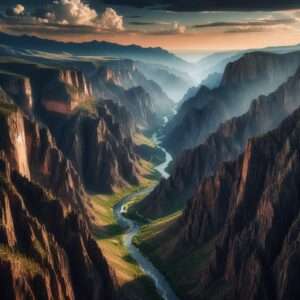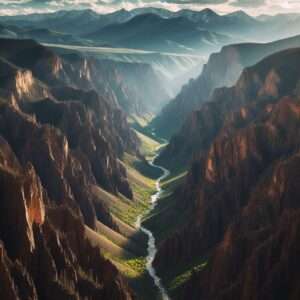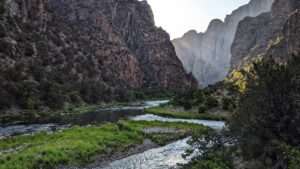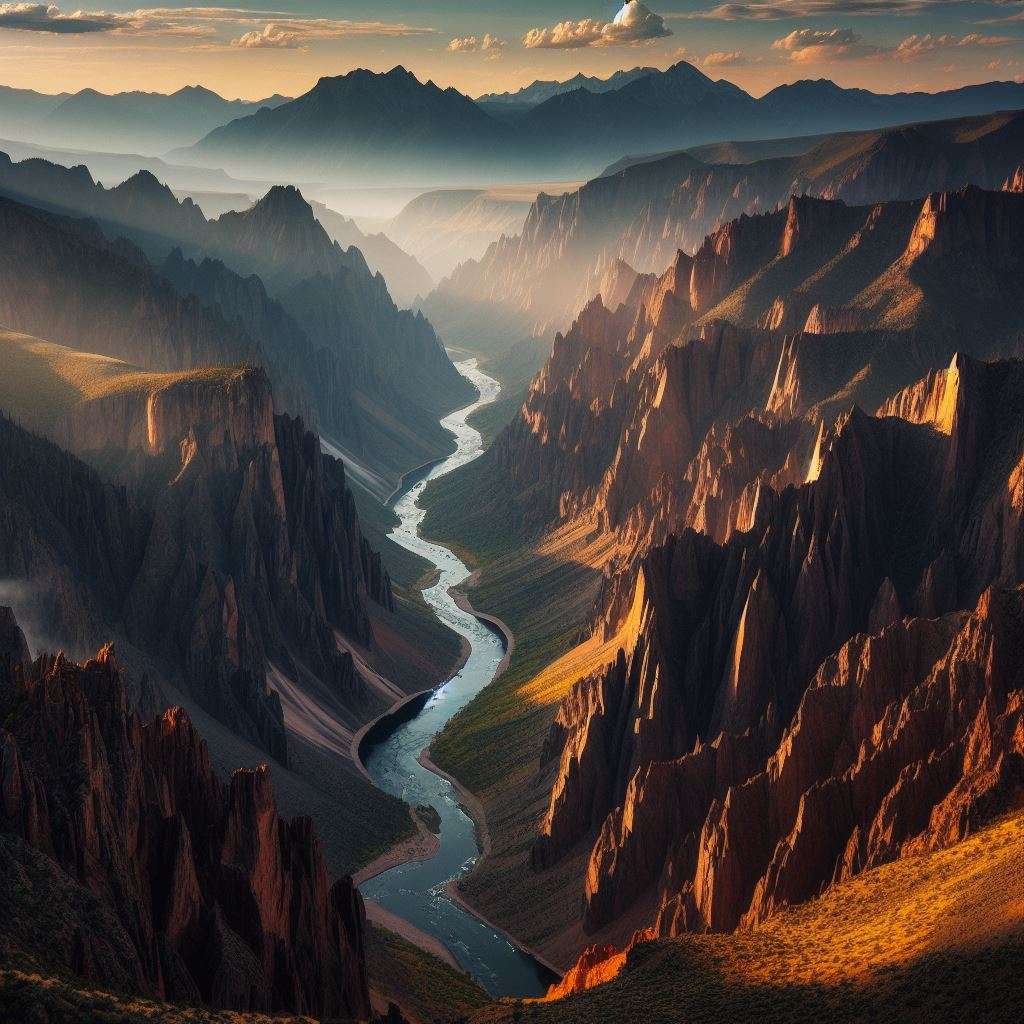Black Canyon of the Gunnison National Park: 8 Spectacular Sights Unveiled
Introduction
Welcome, fellow adventurers, to the mesmerizing realm of Black Canyon of the Gunnison National Park! Nestled in the heart of Colorado, this geological wonder is a treasure trove of breathtaking landscapes and awe-inspiring vistas. As we embark on this virtual journey together, imagine the rugged cliffs standing sentinel over the mighty Gunnison River, carving its way through the deep, dark canyon below.
Black Canyon is not just a park; it’s a living testament to the forces that shape our planet. From the sheer vertical drops to the whispers of the wind echoing through the canyon walls, every step beckons you to explore the mysteries hidden within. Whether you’re a seasoned hiker, a nature enthusiast, or someone seeking a moment of tranquility amidst the grandeur of nature, Black Canyon has something extraordinary to offer.
In this blog, we’re about to unravel the tales of this dramatic landscape, unveiling the seven sights that define its beauty. So, grab your virtual hiking boots, let the anticipation build, and join us on a journey into the heart of Black Canyon of the Gunnison. Get ready to be captivated, inspired, and utterly immersed in the wonders that await!
Attractions in Black Canyon of the Gunnison National Park:
Displayed in the table below are the leading 25 attractions within Black Canyon of the Gunnison National Park, highlighting distinctive features that distinguish each site and render it remarkable.
| # | Attraction | What’s Special |
|---|---|---|
| 1 | Painted Wall | Sheer cliff painted with colorful minerals. |
| 2 | Black Canyon Rim | Breathtaking views of the deep canyon. |
| 3 | Chasm View | Overlook offering dramatic canyon vistas. |
| 4 | South Rim Drive | Scenic drive with multiple overlooks. |
| 5 | North Rim | Less crowded area with stunning views. |
| 6 | Warner Point | High elevation viewpoint with panoramic scenery. |
| 7 | Gunnison Point | Strategic viewpoint overlooking the river. |
| 8 | Pulpit Rock Overlook | Unique rock formation with canyon views. |
| 9 | Oak Flat Loop Trail | Trail offering a close-up experience of flora. |
| 10 | Exclamation Point | Named for its impressive panoramic views. |
| 11 | Crystal Clear Rapids | Spot for observing the Gunnison River rapids. |
| 12 | Tomichi Point | Overlook with views of the canyon and river. |
| 13 | Devils Lookout | Scenic viewpoint with a unique vantage point. |
| 14 | Green Mountain | High elevation area with diverse flora. |
| 15 | Warner Route Overlook | Overlook showcasing the challenging Warner Route. |
| 16 | Smith Fork | Tranquil spot along the Smith Fork of the Gunnison River. |
| 17 | North Vista Trail | Hiking trail with stunning views of the canyon. |
| 18 | Red Rock Canyon | Distinctive red rock formations in the canyon. |
| 19 | Crystal Dam | Scenic area with views of Crystal Reservoir. |
| 20 | Deadhorse Trail | Hiking trail providing an immersive canyon experience. |
| 21 | River View Trail | Trail offering close-up river views. |
| 22 | Warner Point Nature Trail | Short nature trail with interpretive signs. |
| 23 | Dragon Point | Overlook with unique rock formations. |
| 24 | Ranger Station | Information hub with exhibits and ranger assistance. |
| 25 | Cimarron Visitor Center | Visitor center providing insights into the park’s history. |

General Information:
What is Black Canyon of the Gunnison National Park, and where is it located? Nestled in the heart of Colorado, Black Canyon of the Gunnison National Park is a captivating geological marvel known for its deep, dramatic canyons carved by the powerful Gunnison River. The park is situated in the western part of the state, offering visitors a mesmerizing blend of rugged cliffs, unique rock formations, and the roaring Gunnison River, creating an unparalleled natural spectacle.
What time of the year is best to visit Black Canyon of the Gunnison National Park? The ideal time to visit Black Canyon of the Gunnison National Park is during late spring to early fall (May to September). During this period, the weather is generally pleasant, allowing for a more comfortable and enjoyable outdoor experience. The summer months offer warmer temperatures, providing optimal conditions for exploring the park’s trails and taking in the breathtaking vistas.
How can I get to Black Canyon of the Gunnison National Park from Montrose? Montrose serves as the gateway to Black Canyon of the Gunnison National Park, and the park’s South Rim is approximately 15 miles east of Montrose. Visitors can easily access the park by taking U.S. Highway 50 and then turning south onto Colorado Highway 347. The journey from Montrose to the park is a scenic drive that sets the stage for the stunning landscapes awaiting exploration.
Activities and Points of Interest:
What are the top hikes in Black Canyon of the Gunnison National Park? Black Canyon of the Gunnison National Park offers a variety of hiking trails, each showcasing the park’s unique features. Notable hikes include the South Rim Trail, which provides panoramic views of the canyon, and the challenging but rewarding Gunnison Route, leading adventurous hikers to the river’s edge.
Are there any specific activities for dogs in the park? While pets are allowed in certain areas of the park, they are not permitted on most trails or in the inner canyon. However, the South Rim Campground and North Rim Chasm View Nature Trail are dog-friendly areas, allowing visitors to enjoy the park with their furry companions.
Can I rent an RV for my visit to Black Canyon of the Gunnison National Park? Yes, renting an RV is a convenient option for exploring the park and its surrounding areas. Many rental companies offer RVs with various amenities, providing visitors with the flexibility to camp and immerse themselves in the natural beauty of Black Canyon.
Weather and Seasons:
What is the typical weather in Black Canyon of the Gunnison National Park? The weather in Black Canyon of the Gunnison National Park can vary throughout the year. Summers are generally warm, with temperatures ranging from 60 to 90 degrees Fahrenheit. Winters can be cold, with temperatures ranging from 20 to 40 degrees Fahrenheit. Visitors should be prepared for temperature fluctuations and potential weather changes, especially in the canyon environment.
How does the park’s climate vary throughout the year? The park experiences distinct seasons, with summer being the warmest and most popular time to visit. Spring and fall offer milder temperatures, making it an excellent time for hiking and outdoor activities. Winter can be cold and snowy, limiting some park access, but it provides a serene and uncrowded atmosphere for those seeking a peaceful experience.

Location and Travel:
What are the points of interest on the Southern Rim Road, from Black Canyon of the Gunnison National Park to Glenwood Springs, CO? The Southern Rim Road offers a scenic route from Black Canyon of the Gunnison National Park to Glenwood Springs, passing through picturesque landscapes. Points of interest include the breathtaking Curecanti National Recreation Area, the charming town of Crawford, and the captivating cross fissures overlook, providing stunning views of the canyon.
How far is Aspen, Colorado, from Black Canyon of the Gunnison National Park? The distance from Aspen to Black Canyon of the Gunnison National Park is approximately 180 miles. The journey takes about 4 hours by car, and it offers a scenic drive through the Rocky Mountains, making it a rewarding and visually captivating experience.
Lodging and Services:
Where are the best places to stay near Black Canyon of the Gunnison National Park? There are various lodging options near Black Canyon of the Gunnison National Park, catering to different preferences. The town of Montrose, located nearby, offers hotels, motels, and bed and breakfasts. Additionally, the park provides camping facilities for those seeking a more immersive experience amid the natural surroundings.
Tell me some interesting facts about Black Canyon of the Gunnison National Park. Black Canyon of the Gunnison National Park is a geological marvel, with the Gunnison River carving its way through ancient rock layers, creating sheer cliffs and deep canyons. The Painted Wall, one of the park’s iconic features, rises 2,250 feet and is among the tallest cliffs in Colorado. The park’s unique geology, combined with diverse flora and fauna, showcases the forces of nature that have shaped this captivating landscape over millions of years.
Can you provide information on the establishment and founding of Black Canyon of the Gunnison National Park? Established as a national monument in 1933 and designated a national park in 1999, Black Canyon of the Gunnison National Park preserves a significant portion of the stunning Black Canyon and its surroundings. The park’s creation was driven by the need to protect the unique geological features and diverse ecosystems found within its boundaries. Today, it stands as a testament to the ongoing efforts to preserve and share the natural wonders of this remarkable area with visitors from around the world.
10 Fascinating Facts that Make Black Canyon of the Gunnison National Park a Geological Wonderland
Ancient Artistry: The Black Canyon is not only deep but also ancient, with the rocks at the bottom estimated to be nearly two billion years old, showcasing the enduring forces of nature.
Narrow Passages: The Black Canyon’s narrowest point, known as the Narrows, measures a mere 40 feet wide at its base, creating a striking visual of the river’s power in carving through the hard rock.
Painted Wall Majesty: The Painted Wall, a prominent feature of the canyon, is one of the tallest sheer cliffs in Colorado, towering at an impressive height of 2,250 feet.
Unique River Journey: The Gunnison River within the canyon is known for its steep gradient, making it one of the steepest mountain descents in North America. It drops an average of 34 feet per mile, providing a thrilling experience for river enthusiasts.
Starry Nights: Designated as an International Dark Sky Park, Black Canyon offers exceptional stargazing opportunities. On clear nights, the park’s dark skies reveal a mesmerizing display of stars and celestial wonders.
Diverse Flora and Fauna: Despite the rugged terrain, the park is home to a variety of plant and animal species. From rare wildflowers to elusive wildlife like bighorn sheep and peregrine falcons, the biodiversity adds to the park’s allure.
Gunnison Route Challenge: The Gunnison Route, descending to the river’s edge, is a challenging hike with steep drops and loose rocks. It’s a thrilling adventure for experienced hikers seeking a close encounter with the canyon’s depths.
Curecanti Needle: Within the Curecanti National Recreation Area, adjacent to the park, stands the impressive Curecanti Needle, a volcanic spire that adds to the region’s geological diversity.
Striking Contrasts: The contrast between the dark, weathered rock of the canyon walls and the lighter-colored granite creates a visually stunning and dynamic landscape, especially during different times of the day.
Wilderness in the Modern Age: Despite its grandeur, Black Canyon of the Gunnison National Park remains one of the least-visited national parks, offering visitors a chance to experience the wilderness with a sense of solitude and tranquility.
10 Essential Facts for an Unforgettable Visit to Black Canyon of the Gunnison National Park
Sheer Depth and Steepness: Black Canyon is renowned for its extreme depth and steep, narrow walls, making it one of the most dramatic canyons in North America. Some areas plunge over 2,000 feet straight down, emphasizing the canyon’s breathtaking verticality.
Varied Scenic Vistas: The park offers diverse viewpoints, each providing a unique perspective of the canyon. From the South Rim to the North Rim and various overlooks in between, exploring different vantage points unveils the canyon’s ever-changing landscapes.
Challenging Hiking Trails: While the park has trails suitable for various fitness levels, some, like the Gunnison Route, are challenging. Hikers should be prepared for steep descents and ascents, loose rocks, and rugged terrain when venturing into the inner canyon.
Unique Flora and Fauna: Despite the harsh conditions, the canyon is home to a surprising array of plant and animal life. Keep an eye out for rare wildflowers, mule deer, and the elusive peregrine falcon, adding to the park’s biodiversity.
Dark Sky Designation: Black Canyon has been designated an International Dark Sky Park, providing an exceptional opportunity for stargazing. Visitors can witness a celestial spectacle on clear nights, away from the light pollution of urban areas.
Weather Variability: The park’s weather can be unpredictable, with temperature fluctuations and rapid changes. Visitors should be prepared for varying conditions, including hot summers, cold winters, and potential sudden weather shifts.
Camping Options: Camping is available in the park, offering a chance to immerse oneself in the natural surroundings. Both South Rim and North Rim campgrounds provide different atmospheres and experiences, so choosing the right one depends on preferences.
River Adventures: The Gunnison River within the canyon is popular for both experienced and novice river enthusiasts. From challenging kayaking routes to calmer stretches suitable for fishing, the river adds an adventurous element to the park.
Respect for Wildlife: Wildlife is abundant in the park, including bighorn sheep, mule deer, and various bird species. Visitors should maintain a respectful distance, avoid feeding wildlife, and observe animals in their natural habitat.
Limited Services: Black Canyon of the Gunnison is a remote park, and services within the canyon are limited. It’s essential for visitors to carry sufficient supplies, including water, snacks, and necessary equipment, especially when venturing into the inner canyon.

Top 8 FAQs About Black Canyon of the Gunnison National Park
Q: What makes Black Canyon of the Gunnison National Park unique?
A: Black Canyon of the Gunnison National Park stands out for its exceptionally deep and narrow canyons, carved by the powerful Gunnison River. The park’s sheer cliffs, some reaching over 2,000 feet in depth, create a dramatic and breathtaking landscape. The contrast between the dark canyon walls and the lighter granite enhances the visual impact, making it a geological wonder.
Q: What are the must-visit viewpoints in the park?
A: The park offers several stunning viewpoints that provide different perspectives of the canyon. Some must-visit locations include the South Rim, with popular overlooks like Pulpit Rock and Chasm View. On the North Rim, Exclamation Point and Green Mountain are notable. Each viewpoint offers a unique vantage point, showcasing the diverse beauty of Black Canyon.
Q: Are there family-friendly activities in the park?
A: Yes, Black Canyon of the Gunnison National Park caters to families with various activities. The South Rim Visitor Center features educational exhibits, and easy-to-moderate trails like the Rim Rock Nature Trail are suitable for families with children. Ranger-led programs and Junior Ranger activities provide engaging experiences for young visitors.
Q: What are the hiking options, and are there trails for all skill levels?
A: The park offers a range of hiking trails catering to different skill levels. For a moderate hike, the South Rim Trail provides panoramic canyon views. More challenging options include the Gunnison Route, offering a steep descent to the river. Visitors should choose trails based on their fitness and experience levels.
Q: Can I go camping in Black Canyon of the Gunnison National Park?
A: Yes, camping is available within the park. Both the South Rim and North Rim campgrounds offer campsites on a first-come, first-served basis. These campgrounds provide an opportunity to experience the tranquility of the canyon surroundings, with amenities such as restrooms and picnic areas.
Q: What is the best time to visit the park?
A: The best time to visit Black Canyon of the Gunnison National Park is during late spring to early fall (May to September). Summer offers pleasant weather for outdoor activities, while spring and fall provide milder temperatures, making hiking more comfortable. Winter visits are possible, but some facilities may be closed due to snow.
Q: Is stargazing possible in the park?
A: Absolutely. The park has been designated as an International Dark Sky Park, providing excellent conditions for stargazing. On clear nights, visitors can witness a spectacular display of stars away from the light pollution of urban areas. The South Rim campground is an excellent location for observing the night sky.
Q: Are there guided tours available, and how can I make the most of my visit?
A: While the park does not offer guided tours, ranger-led programs and talks are available seasonally. These programs provide valuable insights into the park’s geology, flora, and fauna. To make the most of your visit, consider attending these programs, planning ahead for hikes, and exploring both the South and North Rims for a comprehensive experience.
You may also consider discovering information about Grand Teton National Park.

